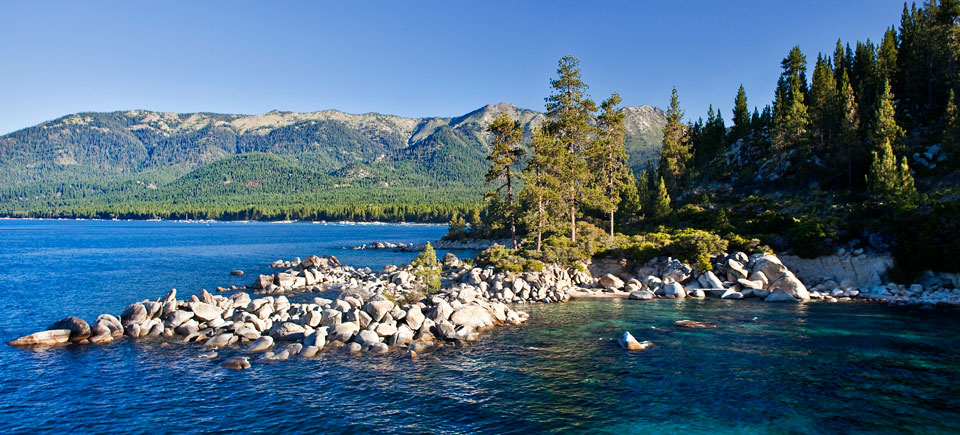It's always been hard work, this collaborative business of uniting the vision of management agencies, research arms of institutions of higher learning and the will of the public regarding the future of Lake Tahoe.
Back in 1997, when Vice President Al Gore's appearance preceded by a day the appearance of President Bill Clinton for the Lake Tahoe Presidential Summit, you didn't need to look much further than Gore's tan Forest Service-issue short-sleeved shirt to see how difficult the work would be.
Gore had hiked part of the trail to Mount Tallac on Tahoe's south shore on the bright and sunny morning of July 25, 1997, to get a better feel for the lake's reputed beauty. The thin mountain air left Gore breathless. The rocky trail had challenged his balance. His shirt was streaked with dark sweat stains.
Yet Gore could see why the trouble would be worth it, particularly as the trail opened up near Fallen Leaf Lake. All of Tahoe's blue splendor was spread out below with a serene cobalt calm.
This wasn't just a local or even regional treasure that was begging for attention. This was a national treasure.
"What a beautiful place," a smiling Gore told a group of pool reporters who were there to greet him following his hike.
Later that morning, during a three-hour open-air workshop in a clearing of pine trees near the amphitheater of the Taylor Creek Visitor Center, Gore spoke of a "consensus" of purpose that would include effort from all with a stake in Lake Tahoe's future.
Sixteen years later, Gore will return to Lake Tahoe to deliver the keynote address for the annual Lake Tahoe Summit. The summit is scheduled for 10 a.m., Monday, Aug. 19 at Sand Harbor State Park on Lake Tahoe's east shore, near Incline Village.
Nevada U.S. Sen. Harry Reid, the man who originally convened the Presidential Summit at Lake Tahoe in 1997 by asking both Clinton and Gore to visit, will host this year's summit.
Since 1997, the work of University of Nevada, Reno researchers, in collaboration with their partners at the Desert Research Institute and institutions from neighboring states such as UC-Davis, has been substantial and noteworthy in the ongoing effort to preserve and sustain Lake Tahoe's future.
University researchers are busy with research that informs public policy makers and finds solutions for Tahoe's future.
Ongoing Tahoe research projects, with key researchers, are:
Warm-water invasive fish: Christine Ngai, project lead and researcher in the University's Aquatic Ecosystems Analysis Laboratory. This pilot project is to determine the effectiveness of mechanical removal methods for management of non-native fish and the restoration of native fish in Lake Tahoe. Her project received international attention this year when her team found a monster goldfish in the Tahoe Keys while electrofishing.
Bottom dwelling invertebrates study: Annie Caires, project lead and researcher in the Aquatic Ecosystems Analysis Laboratory. Bugs living in the muck at the deepest, darkest depths of Lake Tahoe have disappeared in substantial numbers - a 90 percent decline. New funding has allowed continued research to search for the sensitive species and look for ways to support their survival. Sampling of plants and soil in the Camp Richardson area was documented with video from underwater specialists New Millennium Dive Expeditions.
Mountaintop environmental monitoring stations: Graham Kent, director of the University's Nevada Seismological Laboratory. The multiple sites will be connected via the Seismological Laboratory's statewide seismic network to collect and transmit climate and environmental information from remote sensing equipment. The network features 360-degree high-definition cameras to scan the forest and Tahoe communities for wildland fires.
Tahoe ozone nearing unsafe levels: Alan Gertler, vice president for research, DRI. Tahoe is one of the few areas in the region where ozone is increasing. Research also shows that air is a significant source of pollutants that lead to declining water clarity. The largest sources of nitrogen and hydrocarbons are cars, trucks and boats. These sources are also a significant source of particulate pollution.
Collaborations, research framework and public policy: Mike Collopy, assistant vice president for research and the director of the Academy for the Environment at the University of Nevada, Reno. Collopy developed, with funding from the U.S. Department of Agriculture's Pacific Southwest Research Station, a general technical report, "An Integrated Science Plan for the Lake Tahoe Basin: Conceptual Framework and Research Strategies," that is used to help guide Tahoe research and inform Lake Tahoe policy makers in their decision-making process.
Megadroughts in the Sierra Nevada: Kent has confirmed evidence of 200-year-long megadroughts through his earthquake fault research at Fallen Leaf Lake in the Tahoe Basin. Underwater stands of pre-Medieval trees in the lake suggest the region experienced severe drought at least every 650 to 1,150 years during the mid- and late-Holocene period. The last one ended 750 years ago. "It is uncertain when the next megadrought will occur," Kent said. "With climate change upon us, it will be interesting to see how carbon dioxide loading in the atmosphere will affect this cycle."
More information: Lake Tahoe Research
(Editor's Note: With additional writing and reporting by Mike Wolterbeek, University Media Relations.)












